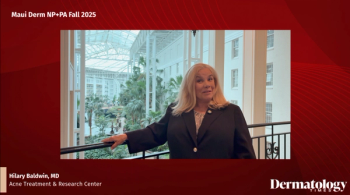
- Dermatology Times, October 2019 (Vol. 40, No. 10)
- Volume 40
- Issue 10
IL-17 inhibitors may fill treatment gap in rosacea
New options may be possible for treatment-resistant and severe rosacea with the use of IL-17 inhibitors as researchers conduct studies on effectiveness.
There’s need for therapies to address treatment-resistant and severe of papulopustular rosacea, and interleukin
Dermatologists primarily use standard rosacea treatments, including metronidazole, ivermectin, azelaic acid and low-dose oral antibiotics, to control symptoms with the medications’ anti-inflammatory effects. But these therapies also have this in common: they act at various stages along the IL-17 pathway, inhibiting IL-17’s downstream products or cytokines responsible for T helper (Th) 17 cell differentiation, according to the authors.
“Until recently, abnormal functioning of the innate immune system and neurovascular dysregulation have been at the forefront of the proposed [rosacea] pathophysiologies,” they write. “However, the role of adaptive immunity, IL-17 in particular, is slowly emerging.”
Among the findings that support IL-17’s role in rosacea, research by Buhl et al found Th1 and Th17 dominance in
Researchers also have reported that the skin of rosacea patients tends to have an increased density of Demodex folliculorum (D. folliculorum), which can lead to the release of more IL-17, according to the review in the Journal of Cutaneous Medicine and Surgery.
The authors point to gaps in treatment efficacy, including that there is no cure for rosacea and current treatment options lose effectiveness with increasing disease severity. Today’s topical and oral treatments relieve symptoms and slow disease progression, but they are associated with relapse when discontinued and treatments are lacking for severe and treatment-resistant papulopustular rosacea, they write.
Since IL-17 plays a pivotal role in papulopustular rosacea development and there are therapies on the market that target the IL-17 pathway, including secukinumab (Cosentyx, Novartis), ixekizumab (Talz, Lilly) and brodalumab (Siliq, Bausch Medical), IL-17 inhibitor drugs should be considered for the treatment of severe and treatment-resistant papulopustular rosacea, the authors reason.
First approved in January 2015, secukinuman has been available the longest, according to the paper. But Stanford University researchers are studying
Secukinumab might also be the safest of the three IL-17 inhibitors, according to the paper in the Journal of Cutaneous Medicine and Surgery.
The high costs of these medications could prevent their use in diseases other than psoriasis and psoriatic arthritis - that’s even if further research reveals they are effective and safe for treatment of severe and treatment-resistant papulopustular rosacea, the authors write.
ÂDisclosures
The paper’s senior author Ronald Vender has received grants and/or research support from Abbvie, Amgen, Centocor, Dermira, Dermavant, Galderma, GSK, Leo, Lilly, Takeda, Novartis, Merck, Pfizer, Regeneron, UCB and participated in speakers bureaus and received honoraria from Abbvie, Amgen, Janssen, Galderma, GSK, Leo, Lilly, Novartis, Pfizer, Bausch-Health, Actelion, Celgene, Cipher, UCB. He has also received consulting fees from Abbvie, Amgen, Janssen, Galderma, GSK, Leo, Lilly, Novartis, Pfizer, BauschHealth, Actelion, Celgene, Cipher, UCB.
References
1. Amir ali A, Vender R, Vender R. The Role of IL-17 in Papulopustular Rosacea and Future Directions. J Cutan Med Surg. 2019;:1203475419867611.
2. Buhl T, Sulk M, Nowak P, et al. Molecular and Morphological Characterization of Inflammatory Infiltrate in Rosacea Reveals Activation of Th1/Th17 Pathways. J Invest Dermatol. 2015;135(9):2198-2208.
3. ClinicalTrials.gov[Internet].Bethesda(MD):NationalLibraryofMedicine(US).2000Feb29- .Identifier NCT03079531, Open label study to assess the effect of secukinumab in moderate to severe papulopustularrosacea;2017Mar14.Availablefrom:https://clinicaltrials.gov/ct2/show/NCT03079531
Articles in this issue
about 6 years ago
Non-melanoma skin cancer increases in the elderlyabout 6 years ago
Looming medical billing and coding changes in healthcare policyabout 6 years ago
Radiodermatitis increasingly common in female breast cancer patientsabout 6 years ago
7 tips to get the most from your social media postsabout 6 years ago
Head and neck melanoma characteristicsNewsletter
Like what you’re reading? Subscribe to Dermatology Times for weekly updates on therapies, innovations, and real-world practice tips.

















